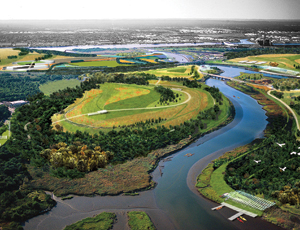Landscape architects are shaping the future of our cities as seen from the sidewalk – and the roof, and the internal courtyard and along the highway. They are responsible for keeping human waste out of our beaches, our cities from burning up in a haze of melting asphalt and our fragile psyches from self-destructing due to too much stress.

Yet there remains an image of the landscape architect as little more than the guy that, well, mows your lawn.
“I still get called a landscaper – a huge pet peeve,” says Karen Twisler, a landscape architect at the Haddonfield, N.J.-based Remington & Vernick Engineers and the president of the New Jersey chapter of the American Society of Landscape Architects. “They’ll ask, ‘what do I do with my grass?’”
While 10 or 20 years ago landscape architects were brought to “green wash” projects, often as an afterthought, they are now spearheading massive city parks such as Governor’s Island and Hudson River Park. They’re being brought in from the outset on million-sq-ft residential developments, such as the 200-acre Port Imperial in New Jersey or the 20-acre public space component on the Hudson Yards in New York. And they’re consulted on the redesign of entire neighborhoods, such as Brooklyn’s Coney Island. The American Society of Landscape Architects, founded in 1899 with little more than a dozen members, now counts 17,600 professionals from every state in the United States. They are in demand.
“I think that’s the future,” says Donna Walcavage, a principal and vice president of the recently merged New York-based EDAW, an LA firm, and Aecom, an engineering firm. “I think LAs will be increasingly at the helm of the large urban regeneration, of urban generation projects – it’s beginning to be seen that space, especially public space, is important as a primary factor.”
And while quaint backyard gardens and immaculate golf courses are all part of the discipline, it is the landscape architect, in conjunction with engineers, that also secures residential areas against natural disasters (by restoring or creating wetlands to prevent flooding, for instance), keep our water potable (by devising systems to replenish groundwater supplies), and, particularly since Sept. 11, secure public locations from possible terrorist attacks. As professionals versed in all of these aspects, it’s not surprising that landscape architects are now brought in to head the projects.
“It became clear to me that the LA is so critical in bringing together all the different disciplines – the mechanical engineers, the civil engineers, the architects – and laying the groundwork, no pun intended, for how the whole structure, or city, or campus, or collection of buildings might work together,” says Susannah C. Drake, president of the N.Y. ASLA and principal of Brooklyn-based dlandstudio llc. Her firm takes a multi-disciplinary approach to urban design, even having full-time sculptors on staff.
“I certainly see a lot more RFPs that list the landscape architect as prime,” says Signe Nielsen, founder of New York-based Mathews Nielsen. “And it’s not just parks – we just submitted an RFP for an infrastructure project, with an engineer, but still, as a prime.”
Nielsen says she’s noticed architects bristling at this idea, but Richard Bell, executive director of the New York chapter of the American Institute of Architects, thinks of it as more of a chance for collaboration.
“It’s much more of a partnership now,” says Bell about the relationship between architects and landscape architects. “In the past an architect would hire a consultant and they would give them a template...

Post a comment to this article
Report Abusive Comment